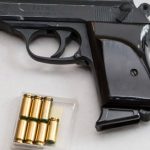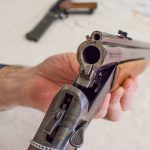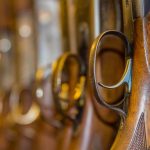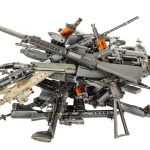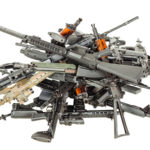Gunpowder to Genocide: A History of Violence by the Use of Firearms
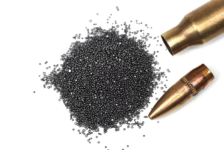
Amnesty International estimates that more that 500 people a day die worldwide each day as a result of violence involving the use of firearms (which the organisation calls ‘guns’); a figure which excludes killings in war zones.
The human rights body asserts that a further 2000 people are injured each day and 2,000,000 live with permanent gunshot wounds.
It calls for restrictive gun control laws to be implemented worldwide, which it says will drastically reduce these numbers.
But how did it all come to this?
In the beginning
Gunpowder was invented by the Chinese in the nineth century AD and the first firearm – known as a ‘fire lance’ – is also believed to have been created by that nation in the tenth to twelfth century AD.
The weapon was initially used to shock an adversary and make it easier to subdue the target.
But as the explosiveness of gunpowder improved over the decades, it became used as a device capable of inflicting serious and even fatal wounds in and of itself.
Across borders
While the weapon was adopted on a limited basis in other nations, it was not until the fourteenth century that effective handheld ballistic weapons really began to make their mark.
The modern firearm
Fast forward to Europe in the 1320s, when a concerted effort was said to be made to produce a device capable of efficiently dispatching enemy combatants – an endeavour which some historians assert culminated in the invention of the ‘hand cannon’.
There is, however, debate about the origins of the device as the examination of a Heilongjiang hand cannon, excavated from an archeological site in China, dated it back to 1288.
Evolution and refinement
Over the centuries that followed, portable ballistic weapons including firearms such as rifles and pistols became more efficient, accurate, durable and powerful – ultimately leading to the vast array of devices manufactured across the world today.
And as debate rages in many nations about the extent to which these weapons should be made available to civilians and even certain law enforcement agencies, there can be little question that firearms have played a significant role in shaping world history.
In our own corner of the world, these weapons were, of course, instrumental in enabling to perpetrate acts of genocide on our Indigenous population, signified by systemic massacres of local Aboriginal populations across the nation – with the spears of our First Nations people being no match for the rifles of the colonists.
But how prevalent are firearms in present day Australia? What is the extent of violence by the use of firearms? And what has been done about controlling access to these potentially lethal weapons?
How many firearms do civilians possess in Australia?
The latest Small Arms Survey Annual Report 2021, released in September 2022, relies on crime databases from around the globe, as well as research conducted by the United Nations Office for Disarmament Affairs (UNODA) and Interpol, amongst other global organisations.
According to the report, Australian civilians legally own in excess of 3.5 million firearms, with New South Wales residents having just under 1 million.
And figures released by the University of Sydney, whose research was undertaken in collaboration with the International Firearm Injury Prevention and Policy Organisation and GunPolicy.org, and verified by the United Nations Trust Facility Supporting Cooperation on Arms Regulation (UNSCAR) suggest a steady increase in the number of registered firearm owners and purchases of additional firearms by exiting owners, as well as a decrease in Australians who feel the need to own a gun.
But while the number of firearms and registered owners appears to have increased in recent years, the report showed a decrease in the number of Australian residents who have died by the use of firearms during the COVID-19 period; a decrease which corresponds with an overall decline in crime rates given the restrictions imposed on movement.
Transnational firearm trafficking
Of greater concern is the illegal transnational trafficking of firearms, which frequently results in weapons falling into the ‘wrong hands’.
In that regard, the 2020 Global Study on Firearms Trafficking and 2019 Study on Homicide undertaken by the United Nations Office on Drugs and Crime (UNODC) in conjunction with the European Union, World Customs Organisation and Crime-Terror Collaboration Database, a study that involved 81 countries, found that seizures of illicit firearms is rare in comparison with the amount trafficked.
The office attributed this in part due to countries deliberately under-reporting seizures, for undisclosed reasons; and as well as the practice of effectively averting detection through disassembling parts and reassembling them at their destination.
The cost of effective enforcement is astronomical and therefore prohibitive, with the vast majority of illegal transnational trade in firearms going undetected.
The low detection rates are notwithstanding the United Nations Firearms Protocol, which is meant to facilitate ‘tracing’ of firearms and their components from the manufacturer to the purchaser.
Unlike illegal drugs, firearms are normally produced legally, but like illicit drugs, transported unlawfully.
Some licensed manufacturers and dealers have even been found to have facilitated unlawful sales to agents of the black market for on-forwarding to sanctioned governments and paramilitary regimes of countries involved in internal armed conflicts, cashing in on the premium added to these illicit sales.
How do firearms get into the wrong hands?
Research by the National Firearm Trace Program, conducted by the Australian Criminal Intelligence Agency (ACIC), suggests that the main mechanism for illegal firearm dissemination is indeed through licensed agents – who use their access to legal weapons to forward them on to those who are not registered to own or possess them).
The Commission found that unlawful imports from other countries accounted for an extremely low percentage of illegal firearms on the black market in Australia.
The program also found many instances of registered firearm owners reporting theft and robberies of their firearms.
Reform produces poor outcomes
Since the ACIC decommissioned the National Firearms Licensing Registration System user interface in 2018/19, forcing law enforcement agencies to use what was considered a more sophisticated system known as the Australian Firearms Information Network (AFIN), it has become harder to track and estimate how many illicit firearms there may be in Australia or their sources.
As ASIC CEO Mike Phelan explained to the Senate in March 2021 by Mike Phelan, access to accurate data is now even more difficult due to the lack of uniformity of Commonwealth, State and Territory laws.
Firearm numbers across the globe
Though figures vary, it is estimated that around 8 million small arms are legally manufactured and sold across the globe every year, an industry which is estimated to be worth USD $8 billion annually. This, of course, excludes illicit sales.
The term ‘small arms’ refers to handguns such as self-loading pistols and revolvers, as well as rifles, sub-machine guns and grenade launchers.
The Small Arms Survey and World Economic Forum estimate that there are one-billion firearms currently in existence, with approximately 857 million in civilian hands (85%), 133 million with the military (13%) and 22.7 million with law enforcement agencies (2%).
Assault rifles
In addition to this, there are believed to be hundreds of millions of assault rifles across the globe, in the hands of civilians, the military and law enforcement agencies.
Perhaps the most famous assault rifle of all time, the AK-47 (also known as the original Kalashnikov) is used in the military in 106 countries worldwide. Another popular rifle is the AR-15, a weapon used in the Robb Elementary School murder of 19 school children and 2 teachers, by a person able to legitimately purchase a weapon, AR-15 (Civilian version of the military model); which originally formed part of a gun ban signed into Law by then US President, Bill Clinton in September 1994.
Three former US Presidents, Gerald Ford, Jimmy Carter and Ronald Reagan had paved the way for what should have ensured additional safety for America’s children, by lobbying the United States Congress. But a decade later, the 10 year ‘sunset clause’ in the legislation expired, when Congress didn’t renew the law. This meant the laws stayed as they were.
The Port Arthur Massacre and its aftermath
The murders of 35 men, women and children in Tasmania, Australia in 1996 ultimately led then Prime Minister John Howard to introduce reforms which made it more difficult to own firearms.
The massacre at Port Arthur, Tasmania, was somewhat predicted by former NSW Premier, Barry Unsworth, who in 1987 stormed out of a National Gun Summit’, stating:
“It will take a massacre in Tasmania before we get gun reform in Australia.”
This statement was prophetic, and Howard’s controversial and polarizing firearm reforms came in the wake of the massacre.
National Firearms Agreement
The National Firearms Agreement of 1996 (NFA) was the single most impactful mechanism for firearm reform in the nation’s history.
The agreement implemented the following reforms, which were implemented thereafter to varying degrees by Australian states and territories:
- Ban on automatic and semi-automatic long-arms other than in exceptional circumstances,
- Nationwide registration of all firearms,
- Establishing categories of firearm types to be used in the licensing of firearms,
- Requirement that applicants for firearm licences demonstrate a ‘genuine reason’ for owning, possessing or using them,
- Introducing basic licence requirements, including the mentioned ‘genuine reason’ requirement, minimum age of 18 years, fit and proper person, proof of identity, training course and safety test,
- Introducing grounds for licence refusal or cancellation and seizure of firearms,
- Uniform standard for security and storage of firearms,
- Introducing firearm permits and minimum 28-day waiting period, and
- Requiring that firearms sales be conducted only by or through licensed firearm dealers.
A firearm buyback scheme and amnesty on prosecution was also introduced, which encouraged the surrender of over 600,000 firearms.
The scheme cost taxpayers around $500 million, raised by the Medicare Levy Amendment Act 1996.
A similar scheme was introduced years later, culminating in a permanent amnesty in 2021.
And while these measures initially reduced firearm numbers significantly, it is believed they are now back to where they were back in 1996.
Quick to get running
According to Associate Professor, Philip Alpers of the University of Sydney, it took then Australian Prime Minister, John Howard and his Deputy, Tim Fischer of the National Party only 12 days to commence the implementation of gun reform after the tragedy of Port Arthur.
Many have seen the measure as a success, while others see Port Arthur as an excuse for the federal government to disarm and thereby control the population.
Deaths involving the use of firearms decline after NFA
According to figures released by the Australian Institute of Criminology and Australian Bureau of Statistics, there were 328 firearm related deaths in 1998
This was the beginning of a decades-long trend in firearm related deaths reducing, although it must be said there have been corresponding reductions in overall violent crime over that period.
A 2020 study titled ‘Controlling Gun Violence – Assessing the Impact of Australia’s Gun Buyback Program Using a Synthetic Control Group Experiment’, did however conclude that the National Firearms agreement had contributed to the reduction in deaths, concluding:
“Australia’s 1996 gun law reforms were followed by more than two decades free of fatal mass shootings and accelerated declines in firearm deaths, particularly suicides. Total homicide rates followed the same pattern. Removing large numbers of rapid-firing firearms from civilians may be an effective way of reducing mass shootings, firearm homicides and firearm suicides.”
Similar trends have been experienced in several other nations after the introduction of firearm control measures, including a number of countries in Western Europe, New Zealand, Japan, South Korea and Singapore.
In the wake of the Christchurch massacre, many accused New Zealand Prime Minister Jacinta Ardern of leaving reforms a bit late, but the tragedy did trigger the enactment of tough firearm control laws in that nation.
That massacre was perpetrated by a registered firearm owner. Indeed, it was an Australian citizen who massacred 51 people, injuring many more, at the ‘Al Noor and Linwood Mosques’, in Christchurch, New Zealand in 2019.
The killer, Brenton Tarrant, whose name is never mentioned in New Zealand, had legally purchased certain guns and ammunition for sporting purposes, having been granted a licence.
New Zealand ‘Gun Laws’, which hadn’t significantly changed since the early 1990s, have now undergone reform, bringing it more into line with that of Australia.
On the other hand, the United States of America, in 2020, had in the region of 44,000 people killed by firearms, with approximately 55% by ‘Gun Suicide’; reported as the most deaths in over 20 years.
It was also a ‘Record-Breaking Year’ for the number of firearms purchased by Americans.
Social cost
In addition to the killing and maiming of millions of innocent civilians, there are social implications affecting many more millions, through psychological issues; leading to many illnesses, including opioid and illicit drug addiction, unemployment, homelessness and poverty
New South Wales laws
The main piece of legislation regulating the licensing and use of firearms in New South Wales is the Firearms Act 1996.
The Act has been amended several times since its introduction, implementing controls which it is hoped strike a balance between the genuine need of law abiding citizens to own and use firearms for a range of legitimate purposes, and the need to protect members of the community against their misuse.

